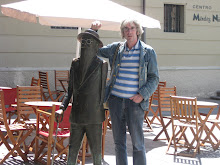I’m going to focus on Scotland because that’s the place I know best. Recently I’ve heard a few claims that bilingual signs (Gaelic & English) are distracting drivers. Firstly, all we are talking about here is toponyms and street names. In other words, signs giving information about the distance to nearby towns, signs at the entrance to towns with the place name on it or street names in towns or cities. These will almost invariably include the English name as well as the Gaelic one, except in places which don’t have a separate English name, such as Drumnadrochit for instance. I’ve never seen or heard the village by Loch Ness referred to as Bridge of Drum, which is the literal meaning in English.
In the comments below a recent BBC article about The Death of Language, one Aberdonian claimed there was a “proliferation of bilingual signs (again in English and Gaelic) in Aberdeenshire. I will be on the lookout the next time I travel through the Grampian region. The poster must have a very different understanding of the word “proliferation” from me. I have never seen a traffic sign (Stop, Reduce Speed, etc) in Gaelic anywhere in Scotland and signposting in shops is conspicuous by its absence, at least outside of the Gaelic-speaking heartlands of the Western Isles and a few other places in the highlands. I haven’t been to those islands for some time but even then I’d confidently state its written presence is minimal in comparison with English. As for the Aberdeen area, I’ve spent plenty of time there, visited recently and can’t recall seeing any Gaelic signs at all!
I’ve seen a few Gaelic signs in and around government buildings in Edinburgh, and in a few places in Glasgow (traditionally the city most Gaelic-speaking highlanders move to for work or study). Glasgow Queen Street railway station is one place that comes to mind. The name of the station is clearly on view in Gaelic. It’s easy for me to remember this specific example as it’s very striking due to the lack of Gaelic in public places in Scotland’s major cities.

You are far more likely to see Gaelic in public places in the highland capital of Inverness or other smaller towns in the Highland region. Particularly in and around council buildings or cultural centres. Also, on street signs, although only in central parts of Inverness as I recall, and again it will always appear bilingually with English. When Gaelic information is given in cultural or tourist sites, it is common to find condensed versions of a more detailed English text. A token word or two of Gaelic at the door, such as “Fàilte” (Welcome) is often considered quite enough. But credit to B&Q for their efforts above as this is a rare site in commercial premises.
Although far more widely used throughout Scotland than Gaelic, the Scots language fares even worse due to its lack of official recognition. You will do well to notice its presence in public at all. It features in poems inscribed on the walls or pavement around the Scottish Parliament Building in Edinburgh. But it’s more likely you will see it in the form of graffiti written by Scots-speakers! However, on the Scottish Parliament website information is available in Scots along with 13 other languages. This is just one example of the current Scottish Government starting to take Scots a bit more seriously as a language that can have a purpose beyond poetry or informal conversation.
Scots also features in place names or in street names (sometimes in monolingual form for the same reason as the Drumnadrochit case mentioned earlier). Some examples can be seen on the website of the Scots Language Centre. However, over the years there have also been many examples of Scottish street and place names being given an English makeover, such as the example of Baxter Wynd being changed to Baker Lane.
Even this minimal exposure to Scotland’s other languages is too much for some. They may tell you that Gaelic is a good thing but yet they are easily inconvenienced and don’t want it to affect their everyday lives in any noticeable way. For that reason, I would argue that some see Gaelic as a form of cultural decoration, something concrete that marks Scotland out from England, but that it must be kept firmly in its place. In other words, it must not interfere at all with the daily routine of a monolingual English speaker.
Another thing some people complain about is the cost of promoting the language. They seem to think that a language will continue to exist or even thrive without financial support and a place in the education system. It’s always easy not to care of course – provided it’s not your own native language that is at stake. That is why many monolingual speakers of a global language like English (or indeed a widespread international language like Spanish) fail to empathise – at the end of the day they know it is not their language that is under threat and so can’t identify with the situation.
